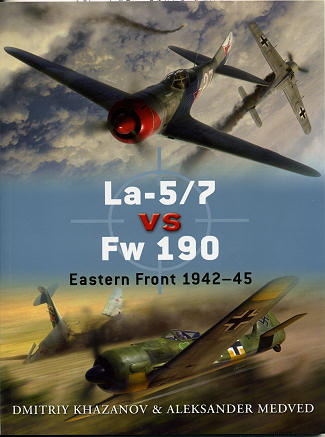 Number
39
in Osprey's popular 'duel' series is this next one on two major protagonists on
the Eastern Front from 1942 until the end of the war. Unlike many of the
opponents in this series, these two are actually quite evenly matched in terms
of design and in terms of performance.
Number
39
in Osprey's popular 'duel' series is this next one on two major protagonists on
the Eastern Front from 1942 until the end of the war. Unlike many of the
opponents in this series, these two are actually quite evenly matched in terms
of design and in terms of performance.
The La-5 was an attempt by Lavochkin to remedy the poor
performance of the Lagg-3, a fighter that was rather decimated by German
experten. Attaching a larger and more powerful M-26 two row radial went quite a
ways toward improving the speed of the aircraft, even when the rest of the
airframe stayed pretty much the same. However, the Soviet aircraft industry
suffered from poor quality workmanship and rarely did a service aircraft perform
to the standards that were required.
Add to it the equally poor training of the majority of
pilots, many of whom were freshly out of flight school, and one can see that the
Germans had a field day shooting down La-5s. Of course, as things go in war,
Soviet quality control and pilot training improved as did the La-5 and as the
German pilots became less experienced, things did turn around. Especially in the
last months of the war when Soviet aces were flying the improved La-7.
On the German side, the FW-190A started on the Eastern Front
with most of its teething troubles cured. Flown by highly experienced German
pilots, they soon made a shambles of the Soviets in the air. This is despite
generally being at a numerical disadvantage. It was only in the last year of the
war, when most air to air 190 units were pulled back to defend the Reich,
leaving ground attack units with the only 190s in theater did the Soviets gain
the upper hand. Ground attack FW-190s were flown by ex-Stuka pilots who had
little training in air to air combat. However, the FW-190F and G were very fast
at low level, making them difficult for the Soviets to catch.
The book's authors follow a tried and true format in this Duel
book by first providing the design and development of both aircraft. There is then
a section on the technical specifications of each followed by a look at the
military in which both were used and how they trained for battle. Next is a look
at the situation in which these aircraft were first used, and then a look at
some of the more important battles in which these two aircraft were used. Finally, an analysis
of how these planes fared; their strengths and weaknesses.
Overall, it makes for a most interesting read and provides a
good look at these two important fighters. It is a book that I thoroughly enjoyed
reading and I'm sure you will as well. Like all Osprey titles it is one that I
can easily recommend to you.
September 2011
For more on the complete line of Osprey books,
visit www.ospreypublishing.com. In the US, it is
Osprey Direct at 44-02 23rd St, Suite 219, Long Island City, NY 11101., where you can
get a catalogue of available books.
If you would like your product reviewed fairly and fairly quickly, please contact the editor or see other details in the Note to
Contributors.
 Number
39
in Osprey's popular 'duel' series is this next one on two major protagonists on
the Eastern Front from 1942 until the end of the war. Unlike many of the
opponents in this series, these two are actually quite evenly matched in terms
of design and in terms of performance.
Number
39
in Osprey's popular 'duel' series is this next one on two major protagonists on
the Eastern Front from 1942 until the end of the war. Unlike many of the
opponents in this series, these two are actually quite evenly matched in terms
of design and in terms of performance.